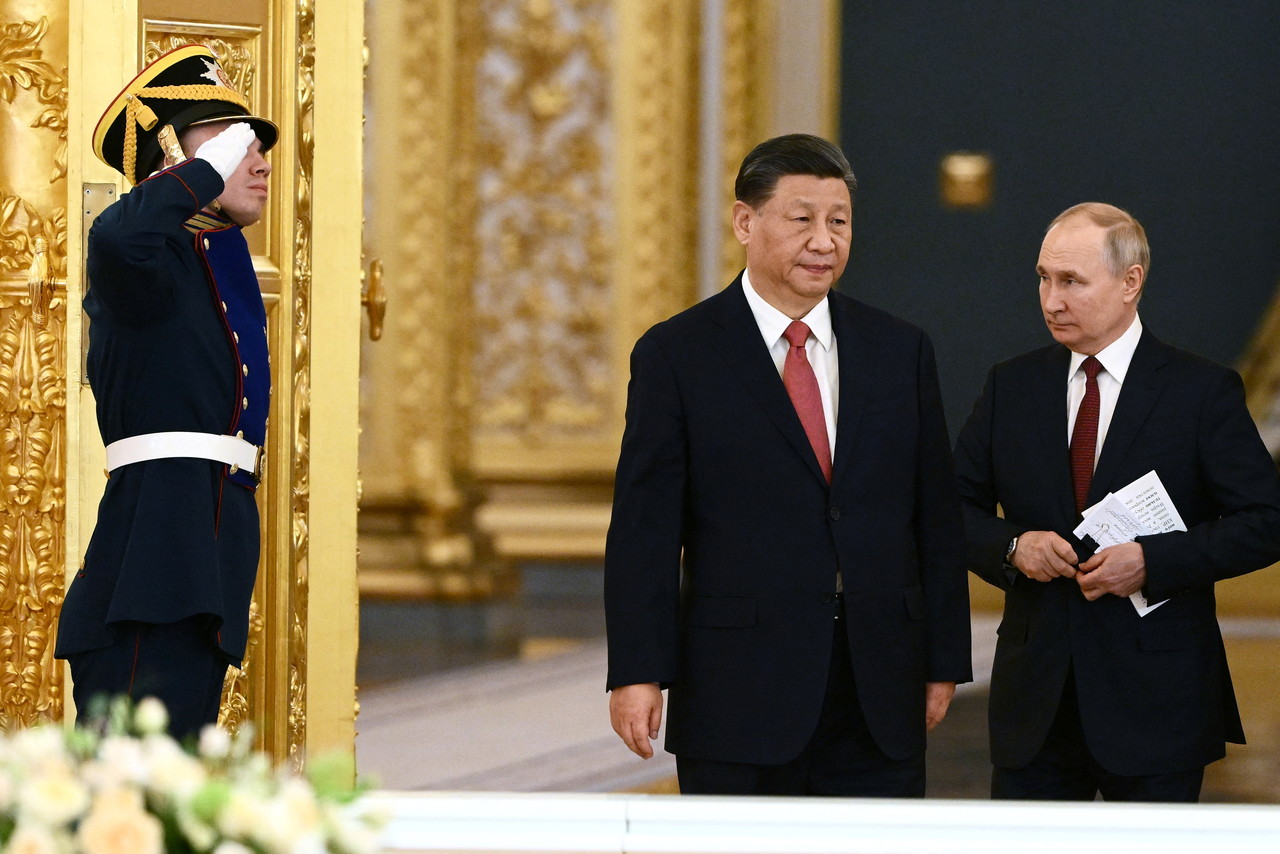Thaw Seemingly Apparent in U.S.-China Relations
In June and July, representatives of the U.S. administration, including Secretary of State Antony Blinken, made a series of visits to China. Their goal was to strengthen dialogue on contentious issues, such as security. No agreement was reached in key areas, but the intensification of high-level contacts helps to control the U.S.-China rivalry. It also creates favourable conditions for a possible meeting of the U.S. and Chinese leaders at the G20 and APEC summits this year. However, those conditions may be short-lived due to growing disputes in areas such as technology.
 LEAH MILLIS/Reuters/Forum
LEAH MILLIS/Reuters/Forum
U.S.-China relations, marked for several years by systemic rivalry in trade and technology, among others, were inflamed by the visit of the then Speaker of the House of Representatives Nancy Pelosi to Taiwan in August 2022 and introduction by the U.S of restrictions on the export of chips and related manufacturing technology in October last year. The U.S. actions were explained as a response to China’s assertive security and economic policy as well as undermining an international law, e.g. in the South China Sea. Tensions temporarily calmed down as a result of the meeting between U.S. President Joe Biden and Chinese President Xi Jinping at the G20 summit in Bali in November last year. However, relations deteriorated again in the months that followed after a Chinese spy balloon was discovered in U.S. airspace before it was shot down by the Americans in February this year (the incident led Blinken to cancel his visit to Beijing in March). That was followed by a meeting between Taiwanese President Tsai Ing-Wen and Speaker of the House of Representatives Kevin McCarthy in California in April.
Then, a series of high-level visits was made, intended to improve relations between the world’s two largest economies. Recently, apart from Blinken, Treasury Secretary Janet Yellen and John Kerry, President Biden’s special representative for climate, travelled to China.
Effects of the Visits
Blinken’s visit on 18-19 June was the first by a U.S. Secretary of State to China in five years. He met with Xi, as well as with the highest-ranking Chinese diplomat, Wang Yi and the then Minister of Foreign Affairs Qin Gang. Blinken raised issues of security, human rights violations in China, the U.S. reducing economic dependence on this country (derisking), the latter’s prohibiting the departure of American citizens from China, as well as the import of chemicals contributing to the opioid crisis in America. Blinken assured the Chinese that the United States would continue the “One China” policy and reaffirmed its commitment to maintaining peace and stability in the Taiwan Strait. The parties also discussed the war in Ukraine, as well as global issues, including climate change and food security. However, progress has not been made on most topics, including the military dialogue suspended after Pelosi’s visit to Taiwan. Only an increase in the number of air connections between the U.S. and China was announced.
On 6-9 July, Janet Yellen, considered to be a supporter of a moderate approach to China, travelled to Beijing. She met with Prime Minister Li Qiang, Deputy Prime Minister He Lifeng, responsible for economic affairs, and Pan Gongsheng, Communist Party secretary of the People’s Bank of China, who was also appointed as the new president of this institution at the end of July. No significant decisions regarding bilateral economic relations were made, but the Treasury Secretary considered the visit to have strengthened the channels of communication between the parties. Yellen has been against decoupling the U.S. and Chinese economies, as potentially carrying very high costs for both sides and the rest of the world, but also stated that the diversification of economic contacts is of great importance to the U.S.. She pointed to the existence of non-controversial areas of U.S.-China cooperation, for example, in trade. This is confirmed by the growing trade in goods, which in 2022 amounted to almost $700 billion, the highest in history. However, Yellen criticised China for engaging in “unfair” trade practices, such as restricting access to the Chinese market. At the same time, she announced that the U.S. will continue to take “limited” measures to protect its security, including in the field of technology. She also called on China not to support Russia in its aggression against Ukraine. The parties also discussed cooperation on global issues, including the climate crisis and the debt of developing countries.
Kerry was the third U.S. representative to visit China, on 16-19 July. He met with Prime Minister Li and China’s special envoy for climate change, Xie Zhenhua, among others. The parties emphasised a positive approach to cooperation in the field of climate, but the bilateral dialogue on this topic, which was suspended in August 2022, has not resumed. No joint arrangements were made before this year’s COP28 climate conference in Dubai. Former U.S. Secretary of State Henry Kissinger was also in Beijing during Kerry’s visit. Although media speculated that his goal was to support the resumption of the military dialogue (he met with Xi and the Chinese defence minister, among others), the American administration described the trip as private.
New Sticking Points
The intensified high-level contacts did not mean a cessation of actions targeting the other side. In spring, China tightened anti-spying laws, including new regulations regarding the transfer of data outside of China. These affect American consulting companies, among others. Their offices were searched and several people cooperating with them were detained. On 3 July, just before Yellen’s visit, China announced restrictions that applied from August on the export of gallium and germanium, metals used in, for example, electromobility and chip production (China is the world’s largest supplier of these raw materials). These actions can be considered as a response to earlier barriers introduced by the U.S. and its allies on the export of technological goods to China. In July, China imposed restrictions on the export of drones and their parts, which are to apply from September. Chinese companies have over 70% of the global market of these products, which are frequently used by U.S. federal institutions and agencies.
In turn, on 9 August, the United States announced the introduction of regulations enabling the prohibition or limitation of investments in China in three sectors: chips and microelectronics, artificial intelligence, and quantum computers (to apply from 2024). In addition, China criticised the short stay in the U.S. in mid-August of William Lai, the vice-president of Taiwan and a candidate in next year’s presidential election, as a part of his trip to Paraguay. In response, China conducted military drills in the Taiwan Strait. There are also new reports about China supplying dual-use equipment to Russia, including drones. In July, the U.S. accused Chinese hackers of accessing emails of the U.S. administration, including the State Department. They also accuse China of conducting espionage activities from a base in Cuba.
Conclusions and Perspectives
Intensification of the U.S.-China dialogue, despite the remaining tensions in their relations, is conducive to avoiding misunderstandings that could turn into an open conflict. Both the U.S. and China want to present themselves as responsible actors and emphasise the possibility of coexistence, as well as maintaining communication. However, China’s reluctance to resume the security and climate dialogues may have a negative impact on its international image. Both sides will have to determine which areas they can cooperate in without compromising their security interests. Recent visits by U.S. representatives to China have shown that this will be difficult due to, among others, the inseparability of cooperation in global matters, such as climate, from other spheres of bilateral relations and China’s recognition of U.S. technological restrictions as a direct blow to its development potential, which was indicated by Wang. Opportunities for convergent actions can be seen, for example, in reducing the debt of developing countries, which is important for the stability of the global economy. At the same time, China will try to attract American business and use it to influence the U.S. government, as evidenced by visits to China in the first half of the year by Elon Musk, CEO of Tesla, and Jamie Dimon, head of JP Morgan Chase.
An improvement in U.S.-China relations may bring about a Xi and Biden meeting at the G20 summit in New Delhi in September and the APEC gathering in San Francisco in November. The U.S. also announced a visit to China by Secretary of Commerce Gina Raimondo, and a trip to Washington by Wang, who was appointed foreign minister in July. In the near future, however, bilateral relations may deteriorate as a result of, for example, the U.S. introducing investment restrictions and China’s potential response. In the medium term, tensions will persist and may even temporarily intensify in connection with the presidential elections in Taiwan and the U.S. in January and November 2024 respectively. In this context, China is likely to dial up its efforts to weaken transatlantic cooperation. This can be done through economic incentives for EU countries. Attempts to calm U.S.-China relations may encourage, for example, Germany and France, which have strong bonds with the Chinese market, to take action to strengthen EU-China ties. Although the EU will develop trade and investment cooperation with China, it should also strengthen efforts to reduce dependence on it in strategic sectors, such as raw materials, to limit its ability to influence EU-U.S. relations.





